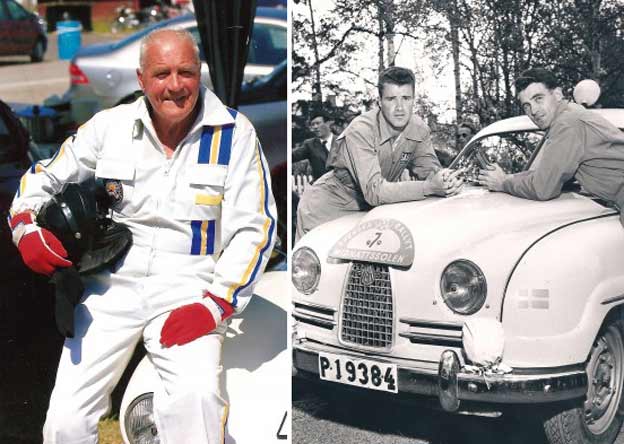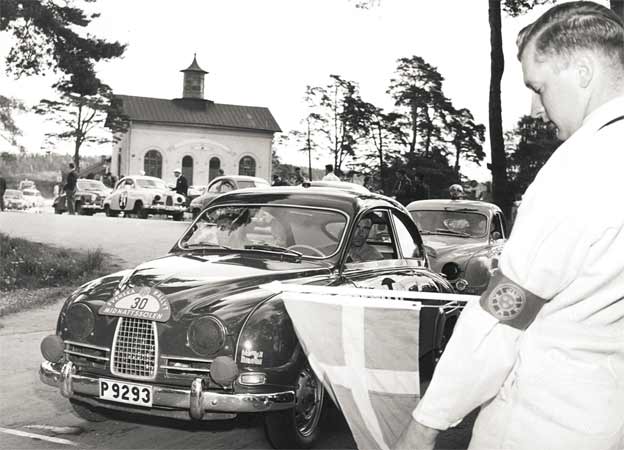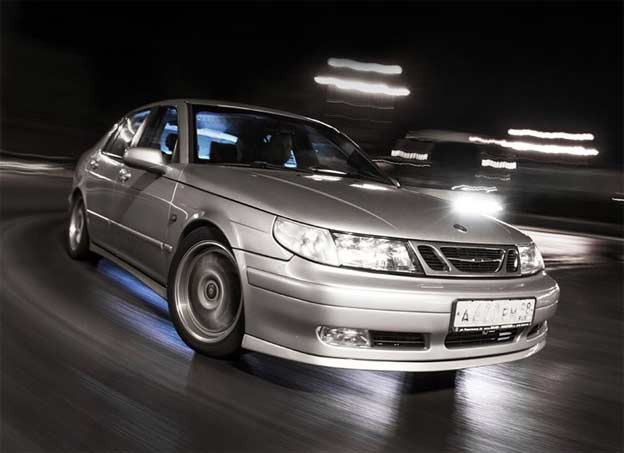It is with great sadness that we announce the passing of Carl-Magnus Skogh, a true legend in the world of rally racing. Skogh, along with his brother Rolf as his map reader, was one of the pioneering drivers at Saab, alongside esteemed colleagues like Rolf Mellde and Erik Carlsson. Known for his elegant driving style and gentlemanly demeanor both on and off the track, Skogh was a highly respected figure in the rally community.
Hailing from Dalsland, Skogh honed his driving skills on the treacherous dirt roads during his professional assignments, which he then applied to his competition driving. One of his remarkable abilities was to drive cleanly and “conserve the car,” ensuring that it reached the finish line without any major damage, despite the challenging road conditions at the time. This exceptional skill earned him immense respect from the mechanics at Saab’s competition department.

Skogh’s elegant touch behind the wheel became his signature. He remained with Saab until 1963 when he made the switch to Volvo, continuing his successful career there. Among the highlights of Skogh’s illustrious career were his total victories in the Midnight Sun Rally in 1960 and 1961, both achieved driving a Saab 96. Another notable achievement was his triumph in the Acropolis Rally in 1965, where he emerged victorious driving a Volvo Amazon.
Rally enthusiasts and connoisseurs around the world mourn the loss of this extraordinary driver from an era when rally sport reached its peak. Skogh’s skill behind the steering wheel and his ability to be a smooth and consistent competition driver earned him the highest regard from his colleagues in the former Saab Competition department.
In a heartfelt interview conducted in 2014, Carl-Magnus Skogh shared insights into his remarkable career and experiences behind the wheel. His brother Rolf served as his co-driver in many of the races, and together, they forged a formidable partnership on the rally circuit. Skogh’s reminiscences provided a glimpse into his early years and the influences that shaped his path in motorsports.
Growing up in Håverud, Dalsland, Skogh’s father served as a forest manager at Håveruds bruk. His father’s passion for motorsports inspired Skogh, and he himself participated in a race in the 1920s. On one occasion, his father was challenged by the mill manager, who took offense at his father driving around in a small car. They competed in an ice racing event on Lake Nären, and although a smaller, lighter car had the potential to go faster, Skogh’s father chose not to cross the finish line first, as defeating his boss would have meant losing his job.

Skogh’s connection with Erik Berger, his childhood friend, played a significant role in his early years. They often competed against each other in junior cross-country skiing and ski jumping, despite not having driver’s licenses. Skogh recounted an incident where they traveled to Årjäng for a ski competition in Erik’s Ford Tudor, which could accommodate four passengers. Erik performed admirably in the competition, securing third place among a field of talented skiers.
On their way to a dance event in Karlanda after the competition, they had a puncture and had to change the tire. The road was icy, and after several unsuccessful attempts, they managed to lift the car with the jack and fix the tire. They eventually arrived at the venue, and despite Erik’s tired legs from the ski competition, he quickly regained his energy once the dancing began. Skogh fondly recalled Erik as an excellent dancer.
Skogh’s rally journey began during the war years when he and his older brother, Lars, owned a Ford Junior. They used the car for measuring timber in the forests of Dalsland and Värmland. As their father purchased standing timber, they had to transport the timber from the logging sites. This led to longer drives to the work locations, prompting them to mix gasoline, which was rationed, with wood alcohol obtained for free from the factory. Diluting the gasoline allowed them to cover longer distances. While their intention was not to drive around with female passengers on Saturdays, it sometimes happened. This frustrated taxi drivers and others who had to rely on wood gas to travel.
The local farmers in Skogh’s hometown found his activities amusing, as there wasn’t much excitement in the area. When he still lived with his parents, they would call his parents to find out which route he would be driving that day. If they planned to go shopping, they might delay their trip to avoid the possibility of crossing paths with Skogh. Fortunately, he never had any accidents with other vehicles.
Skogh’s competitive spirit flourished as he drove his four-wheel-drive Jeep to the logging sites. Sometimes, he would position someone at each end of a scenic forest road to ensure that no other vehicles entered. This exercise served as excellent training, and it was during this time that Skogh decided to acquire a newer car to continue his racing career. The natural choice was Saab, a car manufactured in Trollhättan, Sweden. However, when Skogh mentioned his plans to a few people, he was met with resistance, as they believed he should not purchase a car made in Trollhättan.
Undeterred, Skogh traveled to Trollhättan to order his first Saab. He expressed a preference for a black car but was informed that it was only available in green. Undeterred by the color, Skogh embarked on a successful racing season, participating in over 25 events without a scratch on his car. However, his career took a significant turn when Rolf Mellde contacted him and invited him to join Saab’s second factory team for the Hindås Carousel race. Skogh’s performance was impressive, and as a result, he received some assistance from Saab. Nevertheless, he had to procure his own racing car while the factory provided him with improved shock absorbers and other minor upgrades.
Carl-Magnus Skogh’s career was a testament to his incredible driving skills, strategic approach, and ability to maintain a clean and consistent performance on the rally circuit. His achievements in Saab vehicles, including the consecutive victories in the Midnight Sun Rally and his victory in the Acropolis Rally, solidified his place in motorsport history.
As we bid farewell to Carl-Magnus Skogh, our thoughts and condolences go out to his wife Gun and children Eva and Magnus, along with their families. His remarkable legacy as a rally driver and his contributions to the sport will be remembered and celebrated by enthusiasts around the world.










